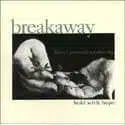
Martha White’s smile is starting to fade. Her enthusiasm has melted to strained concern. Now looky here, she’s starting to pout. “Goodness gracious!” she exclaims, “it hain’t right!” Little Martha is appalled at Ron Thomason’s outlandish liner notes for Hold with Hope, the latest release from the Vermont-based bluegrass band Breakaway. After making the tall assertion that “[this] is bluegrass music in its fullest, most all-encompassing, masterfully conceived and executed sense…” Thomason closes his thoughts with a statement that will live in infamy:
“Here there’s no deep ‘holler,’ Appalachian accents. No rough, amateurish timing. No abrasive, nasal twang. For while those elements have long been associated with bluegrass music, they are not its essential elements.”
What heresy! No, give it a stronger word — outright apostasy. Thomason ought to know better than say such a thing. Has he forgotten that, according to several former Blue Grass Boys, when Flatt & Scruggs left Bill Monroe in 1948 they took the essence of bluegrass music with them? That the epicenter of the idiom was uprooted from western Kentucky and planted on the mountainous border where Tennessee (Flatt), Virginia (the Stanley Brothers), and North Carolina (Scruggs) converge? By 1953 bluegrass music, so-called, had become essentially synonymous with indigenous Appalachian folk music. The refinements resulted in a coarser sound, one that expressed the ache and haunt of self-imposed isolation from the rest of the world. While Thomason hails Breakaway as the “future of bluegrass music,” practitioners of the scary, old-fashioned method remain in anonymous abundance (this reviewer’s personal favorite being the unrecorded Jones Brothers & Log Cabin Boys).
Thomason speaks of “holler accents” and “twangs” as if these were unhappy accidents. But imagine telling the Delta blues legend Sleepy John Estes that his ‘crying’, almost unintelligible vocal style, and notoriously bad timing and limited guitar skills were not “essential elements” to his music. Try to convince the thousands of adoring fans here and abroad who were charmed by his simple, earthy eloquence. Or try telling Chuck D. that his form of delivery was not essential to rap music. Clean it up, boys!
Thomason’s alienating thesis places Breakaway in a first down, 15 yards to go situation. Though contemporary, they work within the traditional bluegrass palette, at once placing themselves in the one of the most exacting and uncompromising forms of American music. They tread on holy ground, so they must remove the snowshoes from their feet. Not that being from Vermont is an issue. There are thousands of competent bluegrass bands all over the country and world-wide. But no mulligans are granted for being from outside Appalachia, either. Can they stand the test?
Let me be the first to acknowledge the skill and musicianship displayed on this recording. The overall speed and timing of the band is indisputable. It is easy to understand why they won the Winterhawk Band Contest last year. In particular, Scott Hopkins’ banjo picking is impeccable. Throughout this disc he displays not only dexterity, but a clear sense of phrasing and creativity within each song structure. Taylor Armerding adds a superlative mandolin. However, he’s only a guest musician on this album. Paul Miller’s guitar and Gene White’s fiddle playing are more than competent.
But technical virtuosity alone doesn’t define artistry. That’s why Jimmy Page is a household name and Yngwie Malmsteen is too many consonants running together. And while Breakaway’s playing is near flawless, it is also too slick and too clean to believably evoke that aforementioned, soul-rattling haunt. Junior Barber adds a “resophonic guitar” (evidently these Yanks don’t use a genuine Dobro), and while he employs nice vibrato, his instrument just doesn’t conjure the brown, “hound dog” whine associated with masters like Josh Graves. Peter Riley’s tenor vocal comes oh-so-close to achieving the “high lonesome sound,” but alas, it falls just short like an exhausted climber near the summit of Everest.
Interestingly, some of the best tracks on this disc happen to be original compositions. The instrumentals “Darkness, Darkness” (featuring White’s fiddle in fine fashion) and “Chenango County Blues” are delightful. Riley’s autobiographical homage to departed parents, “Long, Long Dream”, nearly moved this reviewer to tears. And the title track contains the best vocal work on the collection. There is also a rousing cover of Delmore & Mullins “Sophronie” and a plaintive interpretation of Greenberg’s “Faded Prints”. But folkie Woody Guthrie (“Pastures of Plenty”) and honky-tonkin’ George Jones (“Old, Old House”) aren’t bluegrass, and the band’s efforts to spruce these up, though brave, aren’t all that convincing.
Breakaway will continue to gain support in its usual circuit of the Northeast, Midwest, and Canada. In like manner, George Hamilton IV (“Abilene”) became the king of country music in the UK. I for one would like to see Breakaway play a venue like the Stecoah Valley Center in the back-country of Graham County, North Carolina. If they can persuade those folks, for whom bluegrass is an extension of life, I’ll stand corrected on my analysis.
In the meantime, my advice to Breakaway is: don’t ask Ron Thomason to write any more polarizing commentary for your albums. And secondly, consider these words from my wife who, upon hearing Hold with Hope, stated: “this sounds like the kind of bluegrass album Martha Stewart would like.” Fellers, that ain’t the Martha you want to impress.
